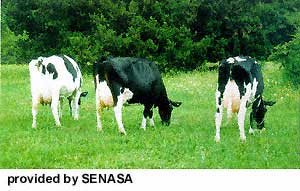Holando-Argentino Cattle
 The Holando-Argentino was introduced into Argentina from Holland in 1880 by president
Julio A. Roca, importing them to the northern regions of the province of Córdoba,
Santa Fe and Pergamino, in the province of Buenos Aires. In 1890 they already appeared
in National Exhibition organized by the Rural Society Argentina with large numbers
of them being exported by the Dutch government.
The Holando-Argentino was introduced into Argentina from Holland in 1880 by president
Julio A. Roca, importing them to the northern regions of the province of Córdoba,
Santa Fe and Pergamino, in the province of Buenos Aires. In 1890 they already appeared
in National Exhibition organized by the Rural Society Argentina with large numbers
of them being exported by the Dutch government.
While originally kept as a dual purpose breed for both meat and milk production the Argentine Holstein is primarily kept for milk production in more recent times. Producers continue to select for increased production to make his business profitable.
The Holando-Argentino is found in fertile regions throughout Argentina. Milk production is found primarily in the river basins located in the humid Pampas integrated by the provincial ones of Buenos Aires, Santa Fe, Córdoba, Entre Ríos and Pampas. Rapid expansion is also seen in the smaller river basins such as Salta, Tucumán, Formosa, Catamarca and Mendoza, zones of very different geographic and climatic characteristics.
Argentina has a climate and environment that is very conducive to cattle ranching, since the majority of the cattle are raised on native forages the Holando-Argentino must maintain its high level of production with a diet that is 60-70% forage and only 30-40% grain and by-product feeds. Because of this and selection through many years the Holando-Argentino is a modern type animal with an excellent feed conversion, giving the producer the ideal balance.
The Holando-Argentino cows are medium sized with the height of 1.40 to 1.5 meters. These animal have a large barrel allowing them to have a high intake of forage.
Its adult weight is between the 600 and 650 kg, which together with an excellent conformation of legs and hooves facilitates their foraging. This is important because in Argentina a cow may travel an area of 5 square km foraging.
The breed has fine skin, flat bones, fine neck, wide nose and mammary system of excellent texture, with good udder attachments, ligament and teat placement. The Holando-Argentino has good longevity, typically having five calving's in a lifetime.
Since 1944, the founding members of the Association Criadores de Argentine Holando (ACHA), created an organization to promote the breed and to provide necessary technical support to accomplish such an aim. With that philosophy, the association has maintained an open herdbook with a series of evaluations an animal must pass in order to be accepted. This evaluation is possible only through the "Official Milk Control" system as declared by law in 1981. ACHA does this work through 96 official offices strategically distributed in all the territory. These offices do the work of gather the data on each animal for the central system.
The Holando-Argentino has been exported to several bordering countries to use in herd improvement, increasing the milk production.
For more information contact: Asociación Criadores Holando Argentino, Laprida 1818 (1452) Buenos Aires,
Phone: 1-805-5481/7323
Fax: 1-805-8352
Email: acha@lyris.com.ar
References
SENASA Argentina, Carlos Moruzz, Coord. área Internet
